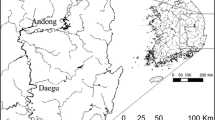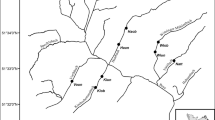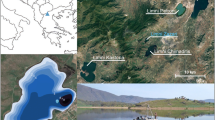Abstract
Dynamic alluvial landscapes offer many possibilities to study primary succession processes on newly developed habitats. However, within the Central European environmental conditions, where watercourses and their riparian spaces are under severe anthropogenic pressures — water regulation, deforestation, lowering of groundwater — natural processes are limited. We studied primary succession on alluvial stream deposits in an artificial lake, where we aimed to follow the terrestrialisation rate and habitat turnover, along with plant species richness and composition across successional stages. In 30 years, a pristine white-willow riparian forest developed. One half of the initially aquatic habitat became terrestrial. The frequency of change, studied on 11250 quadrats 10×10 m each (on a scale from “no change” to 8 changes) and the mean of change per habitat type (most of the habitats changed 2 to 3 times) revealed only one successional trajectory. The percentage flow chart showed a deterministic pathway of succession. The “time since formation” of a terrestrial habitat shows that more than 20% of the lake was terrestrialised within in the first ten years. We studied species richness and composition along three composed transects, following successional stages. We found that the newly assembled riparian white willow woodland has a surprisingly low colonisation rate of plant species.
Similar content being viewed by others
References
Garnier E., Cortez J., Bille’s G., Navas M.L., Roumet C., Debussche M., et al., Plant functional markers capture ecosystem properties during secondary succession, Ecology, 2004, 85, 2630–2637
Pickett S.T.A., Population patterns through twenty years of old field succession, Vegetatio, 1982, 49, 45–59
Tatoni T., Roche P., Comparison of old-field and forest revegetation dynamics in Provence, J. Veg. Sci., 1994, 5, 295–302
Connell J.H., Slayter R.O., Mechanism of succession in natural communities and their roIe in community stability and organisation, Am. Nat., 1977, 111, 1119–1144
Lorang M.S., Hauer A.F.R., Fluvial Geomorphic Processes, In: Hauer F.R., Lamberti G.A. (Eds.), Methods in Stream Ecology, 2nd Edition, Academic Press, Elsevier, New York, 2006
Stanford J.A., Lorang M.S., Hauer F.R., The shifting habitat mosaic of river ecosystems, Int. Ver. The., 2005, 29, 123–136
Maděra P., Packová P., Primary succession of white willow communities in the supraregional biocorridor in the Middle water reservoir of Nové Mlýny, Ekol. Bratislava, 2004, 23, 191–204
Bornette G., Amoros C., Disturbance regimes and vegetation dynamics: role of floods in riverine wetlands, J. Veg. Sci., 1996, 7, 615–622
Nakamura F., Nozomi S., Satomi I., Shifting mosaic in maintaining diversity of floodplain tree species in the northern temperate zone of Japan, Forest Ecol. Manag., 2007, 24, 28–38
Whited D.C., Lorang M.S., Harner M.J., Hauer F.R., Kimball J.S., Stanford J.A., Climate, hydrologic disturbance, and succession: drivers of floodplain pattern, Ecology, 2007, 88, 940–953
Košir P., Čarni A., Marinšek A., Šilc U., Floodplain forest communities along the Mura River (NE Slovenia), Acta Bot. Croat., 2013, 72, 71–95
Kaligarič M., Sedonja J., Šajna N., Traditional agricultural landscape in Goričko Landscape Park (Slovenia): Distribution and variety of riparian stream corridors and patches, Landscape Urban Plan., 2008, 85, 71–78
Ilić D., Panjan J., Nitrogen and phosphorus amount in the Ledava river before and after its outflow into lake Ledava, In: Morell M. (Ed.), Proceedings of the BALWOIS Conference on Water Observation and Information System for Decision Support (25–29 May 2010, Ohrid, Republic of Macedonia), Ohrid, 2010, 1–8
Činč Juhant B., Planjšek M., Geology of Pomurje and Goričko region. Nature of Slovenia Mura river and Prekmurje region. Slovene Museum of Natural History, Ljubljana, 2002 (in Slovene)
Tarboton D.G., Bras R.L., Rodriguez-Iturbe I., On the extraction of channel networks from digital elevation, Data. Hydrol. Process., 1991, 5, 81–100
Balažič S., Mićić T., Bukovnik S., Mišič T., Experts studies for management plan of Ledava and lake, In: Proceedings of 18nd Mišič day of waters in 2007 (10 December 2007, Maribor, Slovenia), Maribor, 2007, 87–93 (in Slovene)
Devilliers P., Devilliers-Terschuren J., A classification of Palearctic habitats. Council of Europe, Strasbourg, 1996
Jogan N., Kaligarič M., Leskovar I., Seliškar A., Dobravec J., Habitat types of Slovenia HTS 2004, Ministry of Environment, Spatial Planning and Energy, Ljubljana, 2004 (in Slovene)
Martinčič A., Wraber T., Jogan N., Podobnik A., Turk B., Vreš B., Flora of Slovenia in brief. Identification key for the ferns and flowering plants, Ljubljana, Slovenia, 2007 (in Slovene)
Naiman R.J., Décamps H., Ecology and management of aquatic-terrestrial ecotones, UNESCO, Parthenon Publishing Group, Paris, Carnforth (UK), 1990
Naiman R.J., Décamps H., The ecology of interfaces: Riparian Zones, Annu. Rev. Ecol. Syst., 1997, 621–58
Karrenberg S., Edwards P. J., Kollmann J., The life history of Calicaceae living in the active zone of floodplains, Freshwater Biol., 2002, 47, 733–748
Kondolf G. M., Anderson S., Lave R., Pagano L., Merenlender A., Bernhardt E. S., Two decades of river restoration in California: what can we learn? Restor. Ecol., 2007, 15, 516–523
Šilc U., Vegetation of the class Salicetea purpureae in Dolenjska (SE Slovenia), Fitosociologia, 2003, 40, 3–27
Čermák J., Nadezhdina N., Field studies of wholetree leaf and roots distribution and water relations in several European forests, In: Bredemeier M., Cohen S., Godbold D.L., Lode E., Pichler V., Schleppi P. (Eds.), Forest Management and the Water Cycle. Ecological studies, 212, 65–88, Springer — Berlin, 2011
Barnes W.J., Population dynamics of woody plants on a river island, Can. J. Bot., 1985, 63, 647–655
Ellenberg H., Vegetation ecology of Central Europe, Stuttgart: Ulmer, 1996, (in German)
Friedman J.M., Osterkamp W.R., Lewis W.M., Channel narrowing and vegetation development following a great plains flood, Ecology, 1996, 77, 2167–2181
Deil U., A review on habitats, plant traits and vegetation of ephemeral wetlands — a global perspective, Phytocoenologia, 2005, 35, 533–705
Casanova M.T., Brock M.A., How do depth, duration and frequency of flooding influence the establishment of wetland plant communities?, Plant Ecol, 2000, 147, 237–250
Brock M.A., Britton D.L., The role of seed banks in the revegetation of Australian temporary wetlands, In: Wheeler B., Shaw S., Fojt W., Robertson A. (Eds.), The Restoration of temperate wetlands, John Wiley & Sons, Cambridge, 1995
Wilson E.O., The species equilibrium, In: Woodwell G.M., Smith H.H. (Eds.), Diversity and stability in ecological systems, Brookhaven Symposium in Biology 22, Springfield, USA, 1969, 38–47
Rejmanek M., Rejmankova E., Biogeography of artificial islands: effects of age, area, elevation and isolation on plants species richness, Preslia, 2002, 74, 307–314
Škornik S., Šajna N., Kramberger B., Kaligarič S., Kaligarič M., Last remnants of riparian wooded meadows along the middle Drava River (Slovenia), Folia Geobot., 2008, 43, 431–445
MacArthur R.H., Wilson E., The Theory of Island Biogeography, Princeton, New Jersey, 1967
Author information
Authors and Affiliations
Corresponding author
About this article
Cite this article
Ignjatović, M., Kaligarič, M., Škornik, S. et al. Spatio-temporal patterns along a primary succession on alluvial sediments. cent.eur.j.biol. 8, 888–897 (2013). https://doi.org/10.2478/s11535-013-0205-x
Received:
Accepted:
Published:
Issue Date:
DOI: https://doi.org/10.2478/s11535-013-0205-x




